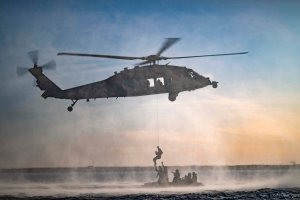
72 years ago the U.S. Army carried out its first and only nuclear artillery test.
The military actually made an atomic artillery shell, loaded it into a 280mm cannon and fired it. And it worked.
Task & Purpose has covered many of the dangerous, strategically questionable and outright bizarre Cold War-era nuclear weapon designs and programs. The nuclear cannon used in Operation Upshot-Knothole wasn’t quite as risky as the Davy Crockett — at the very least the range that the “atomic cannon” had was greater than the smaller Davy Crockett. The May 25, 1953 test came at a time when there was a wider attempt to add atomic weapons into more conventional military weapons.
Operation Upshot-Knothole was a series of tests carried out between March 17-June 4, 1953. They were “intended to test nuclear devices for possible inclusion, in the U.S. arsenal, to improve military tactics, equipment, and training, and to study civil defense needs,” the Defense Nuclear Agency wrote. Most of the tests involved air dropping or static, ground-based atomic detonations, according to the Defense Threat Reduction Agency. The artillery portion of the test, codenamed “Shot Grable,” took place towards the end of Operation Upshot-Knothole.
Technically overseen by the Atomic Energy Commission, Operation Upshot-Knothole featured a large U.S. military presence. Thousands of troops, alongside military scientists and observers, were there to help stage the tests and carry out their own training as part of the Desert Rock exercises.
For “Shot Grable,” the Artillery Test Unit from Fort Sill carried out operations on the cannon. According to the Nevada National Security Site, two 280mm cannons were brought in, and roads had to be paved for them to be put into place, given the weight of each artillery piece. Additionally, 2,600 troops were on hand for exercises coinciding with the test. The atomic shell was given the designation of “W9,” while the special cannons made for it were called the M65, later nicknamed “Atomic Annie.”
At 8:30 a.m., May 25, 1953, they fired the cannon. The nuclear shell flew 6.25 miles, detonating a few hundred feet above ground with a yield of 15 kilotons. The blast was as powerful as the bomb dropped on Hiroshima. Soldiers in trenches and foxholes watched as the mushroom cloud rose over the Nevada grounds. Teams tried to get closer to inspect the impact of the blast but couldn’t get closer than 0.9 miles from the epicenter of the detonation.
Although the May 25, 1953 test would be the only time the nuclear artillery shells would actually be fired, the U.S. military liked the test so much it manufactured several more of the artillery pieces themselves.
Only one cannon would fire a single round during Operation Upshot-Knothole, but the battlefield applicability of such a weapon was clear. Even just one of these could take out a large enemy position. And presumably one salvo would be enough. And the Army seemed to agree on the effectiveness. Nearly two dozen atomic cannons were made, but only were fielded for a few years.
Despite the success of “Shot Grable,” the atomic artillery approach would soon end up obsolete, like several other early Cold War weapons ideas. Smaller, more compact artillery designs as well as the development of intercontinental ballistic missiles meant the need for relatively closer range nuclear strike capabilities diminished.
The latest on Task & Purpose
- Army to eliminate 2 Security Force Assistance Brigades, reassign experienced soldiers
- Why the Army’s new XM7 rifle reignited a debate over volume of fire
- Air Force delay on separation and retirement orders isn’t ‘stop loss,’ defense official says
- F-35’s close call over Yemen raises questions about how it’s used
- An Army unit’s ‘extreme use of profanity’ was so bad, they made a rule about it

